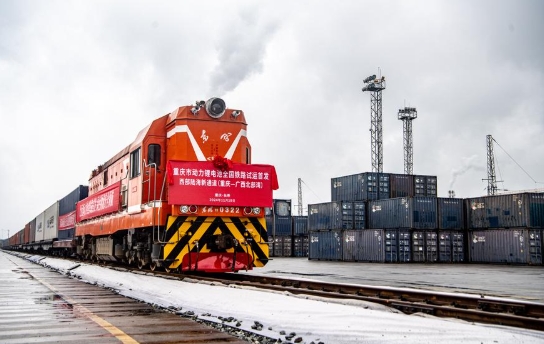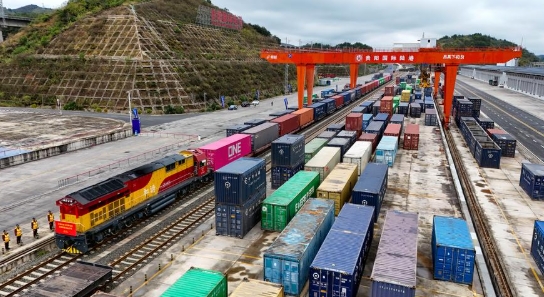Diverse containers empower China's international railway service

A train loaded with lithium batteries for traction purposes is about to depart from a train station in southwest China's Chongqing, Nov. 19, 2024. (Xinhua/Tang Yi)
Three trains loaded with lithium batteries have completed their trips this week, marking the first large-scale trial rail transportation of lithium battery exports for electric vehicles in the country.
For China, one of the world's largest producers of lithium batteries, this is a major step forward in the export of this product.
The trains departed from southwest China's Chongqing Municipality, Sichuan Province and Guizhou Province separately on Tuesday and had reached their destinations in south China's Guangxi Zhuang Autonomous Region and east China's Shanghai Municipality by Saturday.
Previously, the transport of lithium batteries was deemed risky due to concerns over them catching fire or exploding if jolted. As such, they are categorized as dangerous goods and only transported by sea or road.
A new type of container has changed this.
"For the trial run, we are using new containers designed solely for the transport of lithium batteries. The containers are made of non-combustible materials and equipped with smoke and temperature detectors and vent devices," said Jia Ping, deputy general manager of China Railway Chengdu Group Co., Ltd., the operator of the three trains during the trial run.
As China's international trains reach more countries and regions, these special containers show the potential of railway transportation and help more goods go global.
Another case in point is automobile transportation. A traditional 40-foot container can only hold two cars at most. Since last year, some automobile enterprises in China have started to use a new type of container with a metal frame in the middle.
"This adjustable frame can unleash the upper space of the container. Now a 40-foot container can accommodate three to four vehicles," said Wang Lin, director of the port logistics department of Chongqing International Logistics Hub Park, adding that the adjustable metal frame is developed jointly by logistics and automobile enterprises in Chongqing, in a bid to lower the transportation costs.
"The new design reduces the average transportation cost of a vehicle by more than 40 percent," Wang said.

An aerial drone photo taken on Nov. 19, 2024 shows a train loaded with lithium batteries for traction purposes at Dulaying international land-sea logistics port in Guiyang, southwest China's Guizhou Province. (Xinhua/Liu Xu)
For automobile transportation, some places in China also turn to the JSQ freight trains. In October this year, a JSQ freight train loaded with 261 commercial vehicles departed from north China's Inner Mongolia Autonomous Region. Unlike traditional cargo trains, which feature containers, the JSQ has 29 special carriages, each able to accommodate nine to 10 vehicles.
The carriages are interconnected, so the vehicles can be driven into every carriage directly, making loading much more efficient.
According to the China Association of Automobile Manufacturers, in the first three quarters of this year, China exported about 4.31 million vehicles, up by 27.3 percent year on year.
Some foreign enterprises have also been able to consult on container design. Dutch company New Silk Way Logistics has used the China-Europe rail services for eight years. The company introduced temperature-controlled containers to help European pharmaceutical enterprises access the Chinese market.
"Medical products are very sensitive to temperature and transit time. The transit time is only about 18 days by the train, far fewer than by sea," said Hanno Reeser from New Silk Way Logistics, noting that some of the products are meant for public health and patients, so it is important they can further utilize their special containers on this train.
China's international railway service has provided opportunities for European enterprises. More European businesses now choose to use this service, he said.
Editor:伏娅敏
